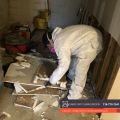Bay Area Homeowners’ Guide to Mold Risks After Natural Disasters

Natural disasters such as floods, storms, and fires can have devastating effects on homes and businesses. Beyond the immediate structural damage, these events often create the perfect environment for mold growth. Mold thrives in damp, humid, and water-damaged areas, making properties vulnerable long after the initial disaster. For property owners in the Bay Area, understanding how natural disasters contribute to mold growth and knowing how to respond is essential for protecting health, safety, and property value.
How Natural Disasters Increase Mold Risks
Floods: Floodwaters can saturate walls, flooring, insulation, and personal belongings. Even after water is removed, moisture often remains trapped in hidden areas such as behind walls or under carpets. This lingering dampness encourages rapid mold growth, sometimes within 24–48 hours.
Storms: Severe storms can lead to roof leaks, broken windows, or structural damage that allows rainwater to seep into the property. Poor ventilation combined with high humidity can create ideal conditions for mold to develop in attics, basements, and other vulnerable areas.
Fires: Fire damage may seem like a dry problem, but firefighting efforts often leave extensive water damage behind. The combination of water from extinguishing efforts, charred surfaces, and heat-damaged materials creates an environment where mold can thrive if not addressed promptly.
In all these scenarios, moisture is the primary catalyst for mold growth. Without immediate and thorough drying, properties are at high risk for infestations that can affect both health and structural integrity.
Common Types of Mold That Appear After Natural Disasters
Natural disasters often lead to specific types of mold infestations, depending on the materials affected and the moisture present:
-
Black Mold (Stachybotrys chartarum): Frequently found on wet cellulose materials like drywall, wood, and insulation. Black mold produces mycotoxins and can cause respiratory issues, headaches, and allergic reactions.
-
Green Mold (Cladosporium): Often grows on damp fabrics, carpeting, and walls. While less toxic than black mold, it can trigger allergies and exacerbate asthma symptoms.
-
White Mold (Aspergillus and Penicillium): Appears as powdery or fuzzy white growth on wet surfaces. It can reduce indoor air quality and contribute to respiratory irritation.
-
Other Varieties: Depending on the environment, gray, yellow, or brown molds may also develop. Each type poses unique challenges for remediation and health safety.
Accurate identification of mold type is critical for determining safe removal methods and preventing recurrence.
Health and Property Risks
Mold growth after natural disasters poses significant risks:
-
Health Risks: Mold exposure can trigger allergic reactions, asthma attacks, skin irritation, and respiratory problems. Children, elderly individuals, and those with compromised immune systems are particularly vulnerable.
-
Structural Damage: Mold feeds on organic materials like wood and drywall, weakening structural integrity over time. Untreated mold can compromise the safety and value of a property.
-
Financial Impact: Delayed identification and remediation of mold can lead to costly repairs, insurance complications, and decreased resale value.
Professional Mold Inspection and Testing
Because mold often grows hidden from view, professional inspection and testing are essential after floods, storms, or fires. Certified mold inspectors, such as Rick Bruce of Bay Area Mold Pros, provide:
-
Thorough Visual Inspections: Identifying visible mold, water damage, and areas at risk for hidden mold growth.
-
Air and Surface Sampling: Collecting samples to determine mold type, concentration, and severity.
-
Detailed Reporting: Providing written documentation for insurance claims, remediation planning, and legal protection.
-
Remediation Recommendations: Offering safe and effective strategies to remove mold and prevent future growth.
Steps Property Owners Should Take
1. Ensure Safety: Only enter the property when it is safe to do so. Check for structural hazards, electrical issues, and unstable areas.
2. Document Damage: Take photos and videos of water, storm, or fire damage for insurance purposes.
3. Remove Standing Water: Begin drying out the property using pumps, fans, and dehumidifiers.
4. Schedule a Certified Mold Inspection: Contact professionals like Rick Bruce to identify hidden mold risks.
5. Implement Remediation: Follow certified recommendations to safely remove mold and address moisture sources.
Protect Your Property and Health
Natural disasters significantly increase the risk of mold growth in homes and businesses. Early detection by a certified mold inspector is essential for protecting health, preventing structural damage, and ensuring compliance with insurance and safety standards.
Bay Area Mold Pros, led by certified mold inspector Rick Bruce, offers expert mold inspection and testing services for properties affected by floods, storms, or fires. With accurate testing, detailed reports, and professional guidance, Rick helps property owners safeguard their investments and create safe, mold-free environments.
Request an inspection today at (650) 762-6228 or visit Bay Area Mold Pros





